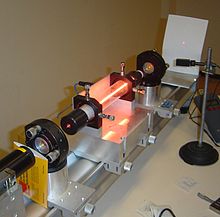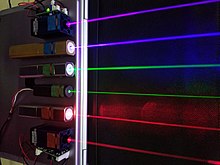Laser
![]()
The title of this article is ambiguous. For other meanings, see Laser (disambiguation).
Laser (/ˈlɛɪzər/, also /ˈleːzər/ or /ˈlaːzər/; acronym for 'light amplification by stimulated emission of radiation') refers to both the physical effect and the device used to generate laser beams.
Laser beams are electromagnetic waves. They differ from the light of a light source used for illumination, for example an incandescent lamp, primarily by the otherwise unattainable combination of high intensity, often very narrow frequency range (monochromatic light), sharp bundling of the beam and large coherence length. Also, with a very wide frequency range, extremely short and intense beam pulses with exact repetition frequency are possible.
Lasers have numerous applications in technology and research as well as in everyday life, from simple light pointers (e.g. laser pointers in presentations) to distance measuring devices, cutting and welding tools, reading of optical storage media such as CDs, DVDs and Blu-ray discs, message transmission, laser scalpels and other devices using laser light in everyday medicine.
Lasers exist for radiation in various ranges of the electromagnetic spectrum: from microwaves (masers) to infrared, visible light, ultraviolet and X-rays. The special properties of laser beams result from their generation in the form of stimulated emission. The laser works like an optical amplifier, typically in resonant feedback. The energy required for this is provided by a laser medium (e.g. crystal, gas or liquid) in which a population inversion prevails due to external energy supply. The resonant feedback usually results from the fact that the laser medium is located in an electromagnetic resonator for radiation of a certain direction and wavelength.
In addition to the discrete energy levels of atomic transitions, there are also laser designs with continuous energy transitions such as the free-electron laser. Since atomic energy levels are limited to less than 13.6 eV, which corresponds to a limit at the wavelength of 90 nm, the X-ray lasers operating in the range of X-rays with wavelengths smaller than 10 nm require designs with continuous energy transitions.

Demonstration laser: In the middle you can see the glow of the gas discharge that excites the laser medium. The laser beam can be seen on the right as a red dot on the white screen.

Different colored lasers
Basic functions
Basic components
Conceptually, a laser consists of three components:
Active medium (laser medium)
In the active medium, photons are created by the optical transition of excited atoms or molecules into an energetically more favorable state. The central condition for a laser medium is that a population inversion can be established. This means that the upper state of the optical transition is occupied with a higher probability than the lower state. Such a medium must have at least three levels and can be gaseous (e.g. CO2), liquid (e.g. dye solutions) or solid (e.g. ruby crystal, semiconductor material).
Pump
In order to bring about a population inversion, energy must be pumped into the laser medium. In order that this pumping process does not compete with the stimulated emission, it must be based on a different quantum mechanical transition. The pumping can be optical (irradiation of light) or electrical (e.g. gas discharge, electric current in laser diodes), bringing the atoms or molecules of the laser medium into excited states.
Resonator
A resonator, for example, consists of two parallel mirrors between which the active laser medium is located. Photons whose propagation is perpendicular to the mirrors remain in the resonator and can therefore repeatedly trigger (stimulate) the emission of further photons in the active medium. A photon produced in this way corresponds in all quantum numbers to the triggering photon. Spontaneous photons that leave the resonator transversely, for example, are accordingly more likely not to stimulate further photons. This selection of the resonator leads to the narrow emission direction of laser radiation. Some resonators are also wavelength-selective (dichroic mirrors, Bragg gratings) and can thus further restrict the oscillating longitudinal modes. In some high-amplification laser media, a resonator is not absolutely necessary to achieve stimulated emission (see superradiator).
How it works
First, atoms in the laser medium are shifted from lower energy levels (e.g. ground state) to energetically higher, i.e. excited states, by the injected power. Thereby, the average decay time of the excited states (usually by spontaneous emission) should be as long as possible. Thus the pump energy remains stored there for a "longer" time, so that an occupation inversion can be built up. Now, stimulation of an atom by a photon with the energy to be emitted is sufficient for the excited atom to fall back into its ground state, emitting a photon of identical energy (i.e. identical wavelength and frequency) and identical phase position as the stimulating photon. Both photons move in the same direction. Due to this doubling of the stimulating photon, the laser medium acts like a light amplifier. The "freshly created" second photon can then in turn stimulate other excited atoms to emit, and a chain reaction occurs.
In addition to this amplifying effect, the arrangement is located in a resonator (see below for laser resonator), which is tuned to the desired wavelength by its dimensions. Thus, if a photon passes through the laser medium several times, it has enough chances to stimulate other atoms. The resonator is basically formed by two mirrors at the ends of the array. These mirrors also finally determine the direction of the generated light beam. One of the two mirrors is designed to be partially transparent, so that part of the light can escape and be directed to its use.
History
Albert Einstein described stimulated emission as a reversal of absorption as early as 1916. In 1928, Rudolf Ladenburg succeeded in providing experimental proof. After that it was puzzled for a long time whether the effect could be used for the amplification of the light field, because for reaching the amplification an occupation inversion had to occur. But this is impossible in a stable two-level system. Initially, a three-level system was considered, and calculations revealed stability for radiation in the microwave range, realized in 1954 in Charles H. Townes' maser emitting microwave radiation. Subsequently, work was also done by Townes and Arthur L. Schawlow, among others, to transfer the maser principle to shorter wavelengths. Optical pumping was introduced in the early 1950s by Alfred Kastler. In the 1950s, Soviet scientists and Nobel laureates Alexander Mikhailovich Prokhorov and Nikolai Gennadyevich Bassov also independently discovered the maser principle and optical pumping, and Prokhorov proposed its realization at shorter wavelengths in a ruby laser in 1958. The first laser - a ruby laser - was completed by Theodore Maiman on May 16, 1960. The first gas laser, the helium-neon laser, was also developed in 1960 (Ali Javan, William R. Bennett, Donald R. Herriott).
The term was coined in the late 1950s by Gordon Gould in reference to the maser; Gould first used the term in his notes in 1957. Early publications still called the laser optical maser.
Further development then led first to various gas lasers (oxygen, nitrogen, CO2 lasers, He-Ne lasers) and then to dye lasers (the laser-active medium is liquid) by Fritz P. Schäfer and Peter Sorokin (1966). A further development of crystal technologies allowed a very strong extension of the spectral useful range. Tunable lasers for approaching a specific wavelength and broadband lasers such as the titanium-sapphire laser ushered in the era of ultrashort pulse lasers with pulse durations of pico- and femtoseconds in the 1980s.
The first semiconductor lasers were developed in the 1960s (Robert N. Hall 1962, Nick Holonyak 1962 in the visible spectral range, Nikolai Bassow), but only became practicable with the development of semiconductor lasers based on heterostructures (Nobel Prize for Herbert Kroemer, Shores Alfjorov). In the late 1980s, semiconductor technology enabled increasingly long-lived, highly effective semiconductor laser diodes, which are used with low power in CD and DVD drives or in fiber-optic data networks and are now gradually replacing the less effective lamp excitation of solid-state lasers as pump sources with powers up into the kW range.
In the 1990s, new pump geometries for high laser powers were realized, such as the disk laser and the fiber laser. At the turn of the millennium, the latter found increasing applications in material processing due to the availability of new manufacturing techniques and powers up to 20 kW, where they can partially replace the types commonly used so far (CO2 lasers, lamp-pumped Nd:YAG lasers). At the end of the 1990s, blue and ultraviolet laser diodes reached market maturity (Shuji Nakamura).
At the beginning of the 21st century, non-linear effects were exploited for the first time to generate attosecond pulses in the X-ray range. This made it possible to track temporal processes inside an atom. In the meantime, the laser has become an important instrument in industry, medicine, communication, science and consumer electronics.
Questions and Answers
Q: What is a laser?
A: A laser is a machine that makes a concentrated, single-color beam of light using special gases or crystals that are energized to emit light.
Q: How does a laser make its light?
A: The gases or crystals in a laser are energized to emit light, which is then amplified or made stronger using mirrors.
Q: Does a laser produce light of many colors?
A: No, a laser produces light with only a single color.
Q: What is collimated light?
A: A narrow, concentrated beam of light that does not get wider or weaker as it travels, unlike most other sources of light.
Q: What is the meaning of the word laser?
A: Laser is an acronym meaning "light amplification by stimulated emission of radiation".
Q: What is the difference between a laser beam and a flashlight beam?
A: A laser beam stays concentrated in a narrow beam, while a flashlight beam spreads out and becomes weaker.
Q: What is the connection between a laser and a maser?
A: The laser was developed from an earlier machine called a maser, and both devices use similar principles to produce amplified light.
Search within the encyclopedia